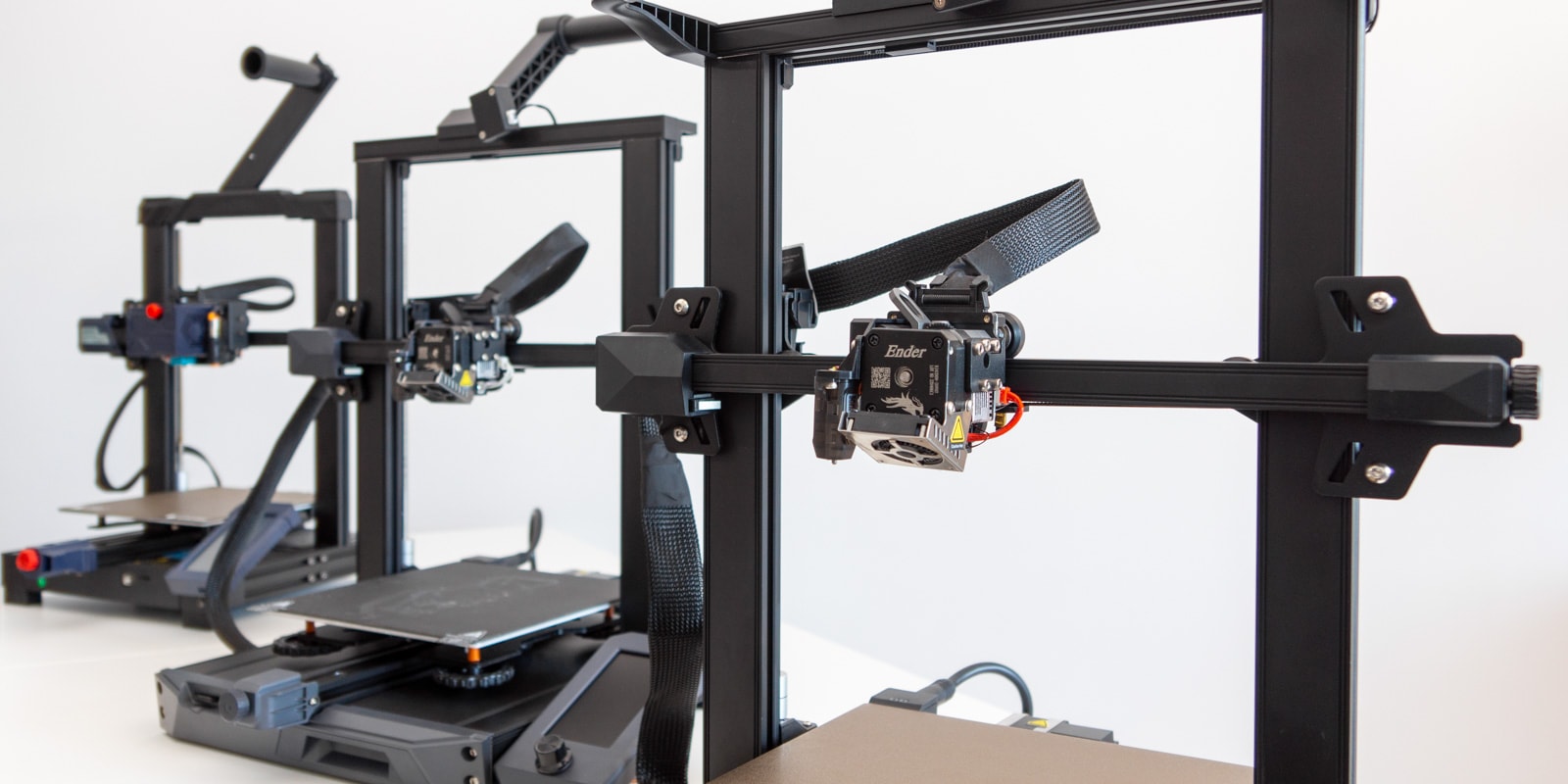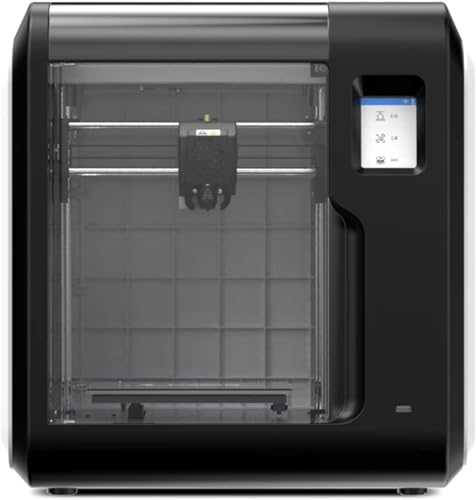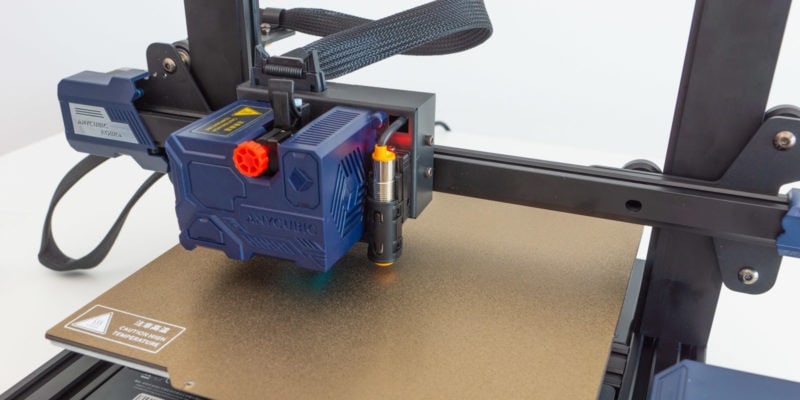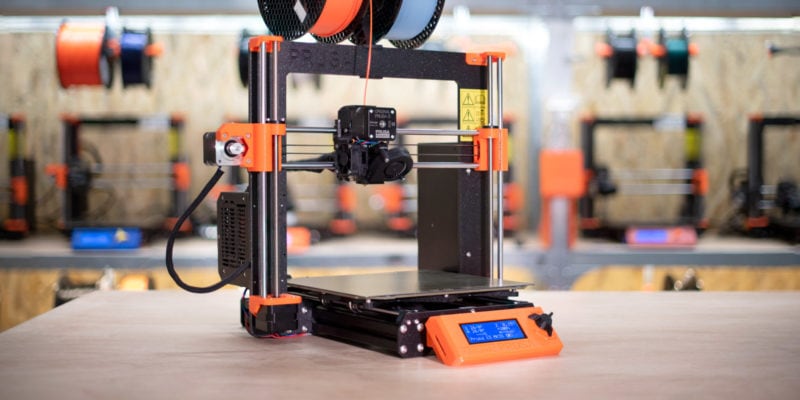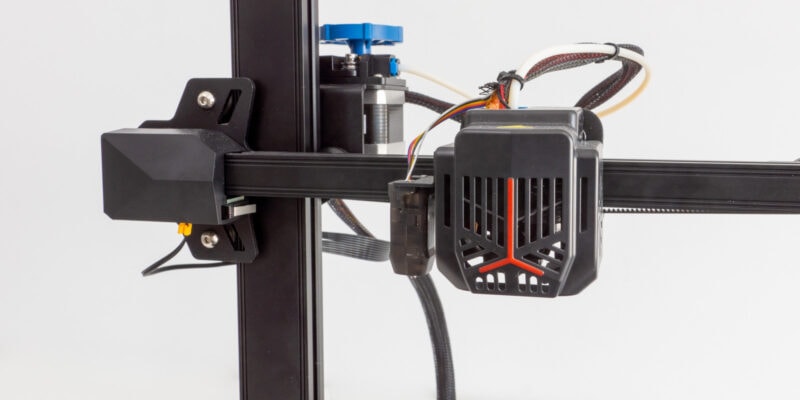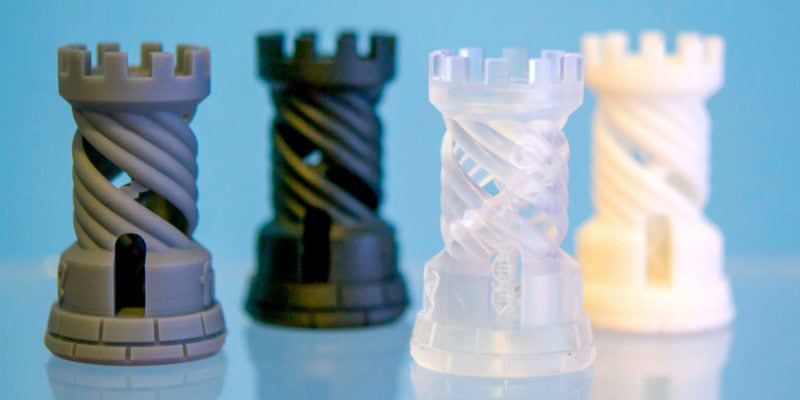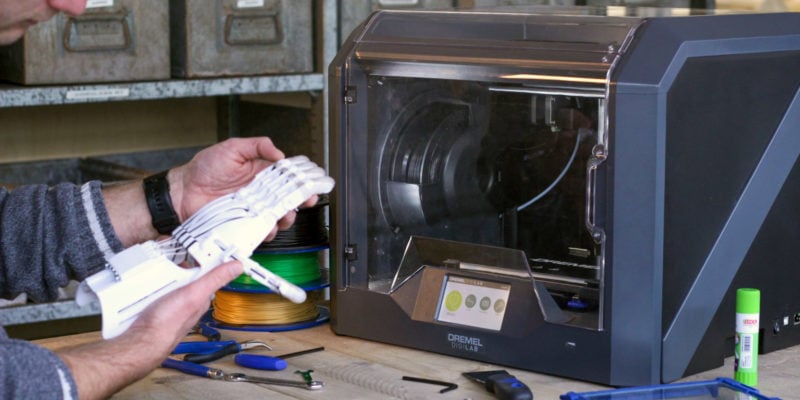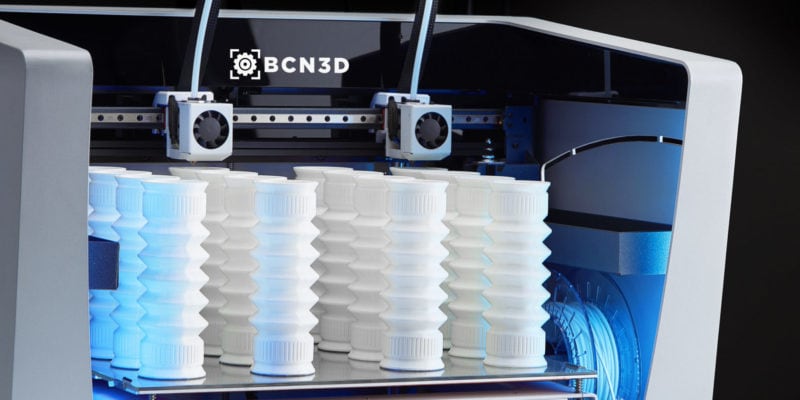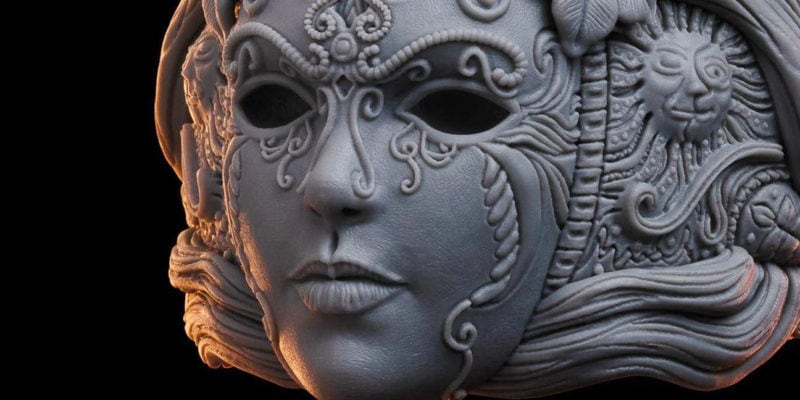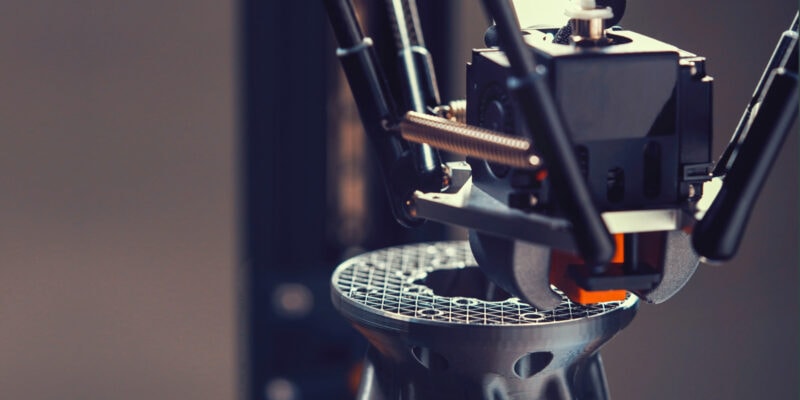Nowadays, you can find 3D printers at a variety of price points. No matter your budget, if you want a 3D printer under $300, a 3D printer under $1000, or anything in between, it is available for you to buy.
Each of these price ranges has its own merits and drawbacks. If you’re looking for a quality machine that won’t break the bank, you’ll want to go for the best 3D printer under $500. These machines offer an excellent blend of print quality and features.
With brands releasing new printers quicker than ever before, however, it is easy to get confused between all the options. To help you out, we’ve curated this up-to-date list of the best 3D printers under $500 currently available on the market. No matter your preference (FDM, resin, enclosed, CoreXY, dual extrusion, etc.), we have included a printer that will suit your needs.
Let’s dive in!
| Best 3D Printer Under $500 | Type | Build Volume | Price | Best Offer |
|---|---|---|---|---|
| Creality Ender 3 S1 | FDM | 220 x 220 x 270 mm | $399 | |
| Creality Ender 3 S1 Pro | FDM | 220 x 220 x 270 mm | $479 | |
| Anycubic Kobra | FDM | 220 x 220 x 250 mm | $299 | |
| Anycubic Photon M3 | Resin | 180 x 163 x 102 mm | $299 | |
| Flashforge Adventurer 3 Pro | FDM | 150 x 150 x 150 mm | $399 | |
| Elegoo Saturn S | Resin | 196 x 122 x 210 mm | $450 | |
| Voron 0.1 | FDM | 120 x 120 x 120 mm | $339 | |
| Anycubic Chiron | FDM | 400 x 400 x 450 mm | $349 | |
| FlashForge Dreamer | FDM | 230 x 150 x 140 mm | $449 | |
| Prusa MINI+ | FDM | 180 x 180 x 180 mm | $459 |
The 10 Best 3D Printers Under $500 in 2024
The Creality Ender 3 S1 is the latest 3D printer in the popular Ender 3 series. It features a brand new design and several new features that make it the current overall best 3D printer under $500.
It comes with an entirely new direct drive extruder from Creality: the Sprite extruder. It has dual metal gears that give you increased pushing force and help achieve better print quality with flexible filaments.
The Ender 3 S1 also has a built-in CRTouch sensor that facilitates 16-point automatic bed leveling. This feature was previously found on more expensive printers and is a fantastic addition to the Ender 3 S1, making it easier than ever to get great prints.
The machine itself is also very well built. It has a sturdy aluminum frame that ensures stability during longer prints. The print surface is a magnetic detachable build plate that can be removed easily after printing. A simple bend and your 3D print will pop right off.
Creality has integrated a dual Z-axis in the Ender 3 S1’s design, giving it improved stability and precision. The inclusion of an easy-to-use LCD screen, filament runout sensor, and resume printing function, are additional features that enhance its user experience.
Despite that, the Ender 3 S1 does have a couple of shortcomings. Lack of a touch screen, poor quality instructions, and underdeveloped firmware are the main gripes we ran into when testing the machine.
At an asking price point of $400, however, these issues can be forgiven. The Ender 3 S1 is an incredible machine that offers a fantastic printing experience.
With its new features, it has firmly established itself as the best overall 3D printer under $500. It makes for an excellent 3D printer for intermediate-level users, small-business owners, and hobbyists who need a reliable printer that delivers great print quality.

Standout Features
- Dual-gear direct extrusion
- CRTouch automatic bed leveling
- Dual Z-axis leadscrew
Technical Details |
|
|---|---|
| Print volume | 220 x 220 x 270 mm |
| Printing technology | FDM |
| Maximum nozzle temperature | 260°C |
| Maximum bed temperature | 100°C |
| Material support | PLA, ABS, PETG, TPU |
| Connectivity | USB Type C, SD Card |
What We Like
- Silent 3D printing
- Easy to level and calibrate the first layer
- High print quality
- Beginner-friendly design
Could Be Better
- Limited connectivity options
- Poor instructions
The Ender 3 S1 Pro is the middle sibling in the S1 series and differentiates itself with some nifty features. Creality has included several advanced features in the Ender 3 S1 Pro that make it a more user-friendly Ender 3 3D printer under $500.
The S1 Pro keeps the same design as the Ender 3 S1, albeit with subtle differences. The hot end is upgraded to print high-temperature materials up to 300 °C, giving you access to additional 3D printing filaments.
It also comes with a 4.3-inch full-color LCD touch screen and an intuitive user interface for easy access to all the features. Compared to the LCD screen with a knob of the Ender 3 S1, the touch screen of the S1 Pro is a welcome addition.
The spring steel magnetic PEI build plate on the S1 Pro gives you excellent bed adhesion, durability, and easy removal of your prints. Again, an improvement over the PC-coated plate of its S1 sibling.
The bed handle and an overhead LED light setup are also neat features in the S1 Pro. They make for an easier-to-use 3D printer, as they take away some of the hassles that are associated with 3D printing.
In terms of negatives, the instructions that come with the Ender S1 Pro are still poorly written and don’t do a great job of explaining how to set up the machine. The machine we tested was also a bit louder than expected, even though that could have been a variation in the individual unit.
At $479, the Ender 3 S1 Pro is the most expensive printer in our lineup. But it’s also the best 3D printer under $500 as long as you don’t mind spending your entire budget.
The combination of its excellent print quality, ease-of-use features, and overall build quality help the Ender 3 S1 Pro stand out from other 3D printers, including the Ender 3 S1. It makes a good choice for prosumers and business owners who need a higher-end 3D printer with advanced features at a relatively low cost.
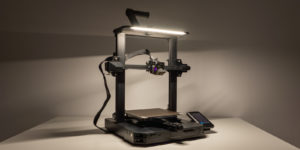
Standout Features
- 300°C high-temperature hot end
- Spring steel PEI build plate
- 32-bit silent motherboard
Technical Details |
|
|---|---|
| Print volume | 220 x 220 x 270 mm |
| Printing technology | FDM |
| Maximum nozzle temperature | 300 °C |
| Maximum bed temperature | 110 °C |
| Material support | PLA, ABS, PETG, TPU, PA, Wood |
| Connectivity | USB Type C, SD Card |
What We Like
- 25 point leveling for the perfect first layer
- Compatible with flexible filaments
- Easy removal of prints
- High print speed
Could Be Better
- Underpowered print cooling fan
- Limited firmware upgradability
The Anycubic Kobra is the newest line of 3D printers by the Anycubic team. It is updated with modern features and priced conservatively, making it one of the best budget 3D printers under $500 available.
The Kobra comes with a typical 220 x 220 x 250 mm build volume that is sufficient to 3D print nearly all of your basic designs. Despite its low price, no compromises have been made in terms of build quality and stability. The Kobra is built with a full metal frame that ensures the machine remains sturdy during operation.
Anycubic has integrated their LeviQ automatic bed leveling feature that calibrates the bed using a 25-point mesh resulting in a perfect first layer print quality and good print bed adhesion. In our testing, we found this to work very well.
The Anycubic Kobra also has some of the best print quality in its price range with very few imperfections. Its direct extruder helps with flexible filaments and gives you greater control over the filament flow.
Its LCD touch screen is surprising at this low price and is both intuitive and user-friendly. The assembly is similar to that of most other 3D printers under $500. It comes partially pre-assembled in a flat pack and takes about 15 minutes to set up.
You will notice that the Anycubic Kobra is rather loud. Its print cooling fan is also underpowered, which can result in some print issues if you’re not careful with your settings.
At $299, however, these problems are easy to overlook. The Kobra is an impressive 3D printer that offers a lot of value for the money and is our pick for the best budget 3D printer under $500.
It makes for a superb first 3D printer for beginners or students in educational institutes. It also is for hobbyists who need to upgrade their previous generation 3D printer to a brand new one at an affordable price.
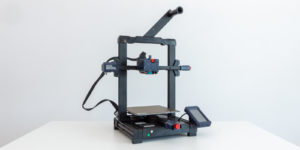
Standout Features
- Auto-bed leveling
- Sensorless homing
- Direct drive extruder
Technical Details |
|
|---|---|
| Print volume | 220 x 220 x 250 mm |
| Printing technology | FDM |
| Maximum nozzle temperature | 260 °C |
| Maximum bed temperature | 110 °C |
| Material support | PLA, ABS, TPU and PETG |
| Connectivity | microSD card, USB |
What We Like
- 25 point leveling for ideal first layer
- Compatible with flexible filaments
- Easy removal of prints
- High print speed
Could Be Better
- Generic power supply
- Limited firmware upgradability
The Anycubic Photon M3 is a budget resin 3D printer offered in the Anycubic’s long line of resin printers. It is the base model in the M3 series of resin printers and comes with some of the best features in its category.
The M3 comes in a modern-looking curvy yet boxy design that helps to differentiate it from other resin 3D printers. It includes a 4K monochrome LCD screen that outputs a respectable XY resolution of 40 microns. This enables you to execute precise printing and reproduce fine details on your intricate prints. Its 400:1 contrast ratio also contributes to that.
Anycubic has ensured that the LCD screen stays usable for a long time, and hence the M3 comes with an anti-scratch protective film on the LCD. The build plate is also texturized to improve the success rate of your 3D prints and help with bed adhesion.
The Photon M3 is fully compatible with the Anycubic ecosystem, giving you access to various materials and 3D printer accessories. It is a great option for beginners venturing into the resin printing world and hobbyists who need good quality 3D prints without spending a lot of money.
Standout Features
- Laser engraved build plate
- 400:1 contrast ratio
- Anti-scratch film
Technical Details |
|
|---|---|
| Print volume | 180 x 163 x 102 mm |
| Printing technology | Resin |
| Material support | 405 nm UV resin |
| Connectivity | USB |
What We Like
- Fast printing speeds
- Reproduces finer details easily
- Excellent bed adhesion
Could Be Better
- Finicky bed leveling
- Limited slicer compatibility
The Adventurer 3 Pro is the top-of-the-line model in the Adventurer 3 series of 3D printers from Flashforge. It comes with many unique features that make it a great enclosed 3D printer on a budget.
The printer comes with both 245°C and 265 °C hot ends set to ensure you get maximum material compatibility. The build plate is made of carbon-silicon crystal glass with excellent flatness. This helps reduce warping and curling, giving you better print quality.
Additionally, the build platform comes factory leveled, eliminating any worry about the print bed leveling procedure before your first 3D print.
To help you get started quickly, the Adventurer 3 Pro comes pre-assembled right out of the box. It also includes automatic filament loading, a filament run out sensor, a quick change nozzle system, and a touch screen for convenience.
The sole drawback is its small build volume of 150 x 150 x 150 mm. Unfortunately, a decreased build volume is a common side-effect of enclosed 3D printers. Especially on a small budget, you can expect to make this trade-off.
So if a large build volume is not your priority, the Adventurer 3 Pro is the best enclosed 3D printer under $500 you can find right now. Its increased safety makes it a superb classroom 3D printer for kids. If you have a child who is looking to learn and explore the 3D printing world, you can’t go wrong with this one.
Standout Features
- Leveling free build platform
- Carbon silicon crystal glass build plate
- Filament auto-loading
- Cloud printing
Technical Details |
|
|---|---|
| Print volume | 150 x 150 x 150 mm |
| Printing technology | FDM |
| Maximum nozzle temperature | 265 °C |
| Maximum bed temperature | 100 °C |
| Material support | PLA, ABS, PC, PETG |
| Connectivity | USB stick, Wi-Fi, Ethernet FlashCloud, PolarCloud |
What We Like
- Ready to print out of the box
- High build quality
- Remote monitoring and control
Could Be Better
- Small build volume
- No air filter
The Elegoo Saturn S is a large format resin 3D printer with a build volume of 196 x 122 x 210 mm. It is designed to be an upgrade over the previous Elegoo Saturn and comes with an improved set of features.
Its large 9.1-inch LCD is a monochrome screen, letting you achieve fast print speeds and get an increased screen lifetime. With a printing resolution of 0.048 mm on the XY axes, it offers excellent reproduction of the finer details in your printed models.
The Elegoo Saturn S comes with a big build plate. To support the large build platform, the machine uses dual linear rails on the Z-axis. These add stability and rigidity to the printer’s metal frame while enabling smooth motion. As a result, you get reduced vibration and ghosting artifacts in your resin prints.
The Elegoo Saturn S houses an inbuilt carbon filter as well. This helps eliminate the foul smell of some 3D printer resins and lets you print indoors with fewer worries.
Considering its features and the large build volume, the Elegoo Saturn S is an excellent printer for large-scale printing miniatures and batch resin 3D printing. It is ideal for hobbyists and small businesses looking for a reliable resin 3D printer under $500.
Standout Features
- Massive build volume
- Dual linear rails on Z axis
- Built-in air filter
Technical Details |
|
|---|---|
| Print volume | 196 x 122 x 210 mm |
| Printing technology | Resin |
| Material support | 405 nm UV resin |
| Connectivity | USB |
What We Like
- Excellent build quality
- Easy to level bed
- Produces detailed prints
Could Be Better
- No Wi-Fi or ethernet port

The Voron 0.1 is a compact CoreXY 3D printer kit born out of the Voron Project group. It is an entirely open-source 3D printer design that you can customize and build as per your needs. Each Voron 3D printer uses high-quality components and aims to deliver the best print quality.
The Voron 0.1 comes with a small build volume of 120 x 120 x 120 mm. Its CoreXY design coupled with Klipper firmware helps you achieve a fast print speed of 120 mm/s. And it is compatible with various all-metal hot ends such as the Mosquito, DragonFly, and the E3D V6 hot end.
There are several variations of the Voron 0.1 design, and each comes with slight differences. Yet, they follow the same design philosophy of using high-end components. You can easily get one of these DIY kits for less than $500. Their low price point makes it a lucrative choice for DIY 3D printer enthusiasts and hobbyists who need a fast high-quality 3D printer on a budget.
Standout Features
- CoreXY design
- Low mass direct drive extruder
- Klipper firmware
Technical Details |
|
|---|---|
| Print volume | 120 x 120 x 120 mm |
| Printing technology | FDM |
| Maximum nozzle temperature | 300 °C |
| Maximum bed temperature | 110 °C |
| Material support | PLA, PETG, ASA, ABS, PC (Polycarbonate), PVA, HIPS, PP |
| Connectivity | USB |
What We Like
- Enclosed build chamber
- High-quality components
- Fully open-source design
Could Be Better
- Small build volume
- Requires extensive assembly
- Can be difficult to source components
The Chiron is a large 3D printer from the Anycubic team. It comes with a massive build volume of 400 x 400 x 450 mm, suitable for large prints, batch 3D printing, and creating cosplay components.
Very welcome on the Chiron is the automated bed leveling feature. It makes it easy to level the big print bed. As a result, you can achieve better first-layer adhesion, which is crucial for prints with a large surface area.
You can interact with the 3D printer using its full-color TFT touch screen. Its user interface is easy to use, and the touch screen functionality removes the need to fiddle around with buttons or rotary knobs.
To detect and stop the printing process if the filament breaks or runs out, the Chiron comes with a filament runout sensor. Combine this with the print resume function, and you can be sure of reliable and uninterrupted long prints.
Some shortcomings of the Chiron are poor cable management and limited upgrade options. Despite those, you can still be hard-pressed to find a better FDM 3D printer under $500 with such a large build volume.
Anycubic has designed the Chiron for easy assembly and quick 3D printing out of the box. It makes the assembly process a breeze for newbies in 3D printing. The price of less than $400 makes it an appealing buy for hobbyists who can fully utilize its big printing area on their various projects.
Standout Features
- Big build volume
- TFT touch screen display
- Automatic bed leveling
Technical Details |
|
|---|---|
| Print volume | 400 x 400 x 450 mm |
| Printing technology | FDM |
| Maximum nozzle temperature | 260 °C |
| Maximum bed temperature | 100 °C |
| Material support | PLA, ABS, HIPS, Wood, TPU |
| Connectivity | SD card, USB |
What We Like
- Sturdy build quality
- Excellent bed adhesion and print removal
- Easily prints with flexible filaments
Could Be Better
- Poor cable management
- Limited upgrade options
Dual extruder 3D printers are usually expensive due to their complicated design and operation process. Yet the FlashForge Dreamer is an exception and provides excellent value for your money with its dual extruders and durable build quality.
The FlashForge Dreamer aims to provide multi-color printing at a relatively low cost. It utilizes an aluminum print bed that ensures even heating of the build surface and the print chamber. This helps prevent warping in higher-temperature filaments, like ABS.
The fully enclosed design helps to keep the heat inside the build area and reduces 3D printer fumes from escaping the enclosure. This is especially helpful if you 3D print in an office or living area.
You also get built-in Wi-Fi connectivity for remote 3D printing, and its 3.5-inch touch screen makes it easy to access the printer’s functionalities when you are using it.
The bundled FlashPrint slicer software is excellent for Flashforge 3D printers, but experienced users might find it limiting in terms of features. You can use other compatible slicers such as Cura, PrusaSlicer, and Simplify3D however.
The Dreamer is mainly aimed at beginners and educational institutes. It is beginner-friendly, safe to use, and pre-assembled out of the box. The feature set, too, is ideal for first-time 3D printer users and primary 3D printing use cases. It is most suitable as a dual extruder 3D printer under $500 for children, beginners, and schools.
Standout Features
- Dual color 3D printing
- Wireless monitoring
- Aerospace grade aluminum build plate
Technical Details |
|
|---|---|
| Print volume | 230 x 150 x 140 mm |
| Printing technology | FDM |
| Maximum nozzle temperature | 240 °C |
| Maximum bed temperature | 120 °C |
| Material support | PLA, TPU 95A, ABS, PETG |
| Connectivity | USB cable, SD card, Wi-Fi |
What We Like
- Controllable enclosure area
- Easy to use touchscreen
- Fully assembled, ready to print out of the box
Could Be Better
- Small build volume
- Limited features in FlashPrint software
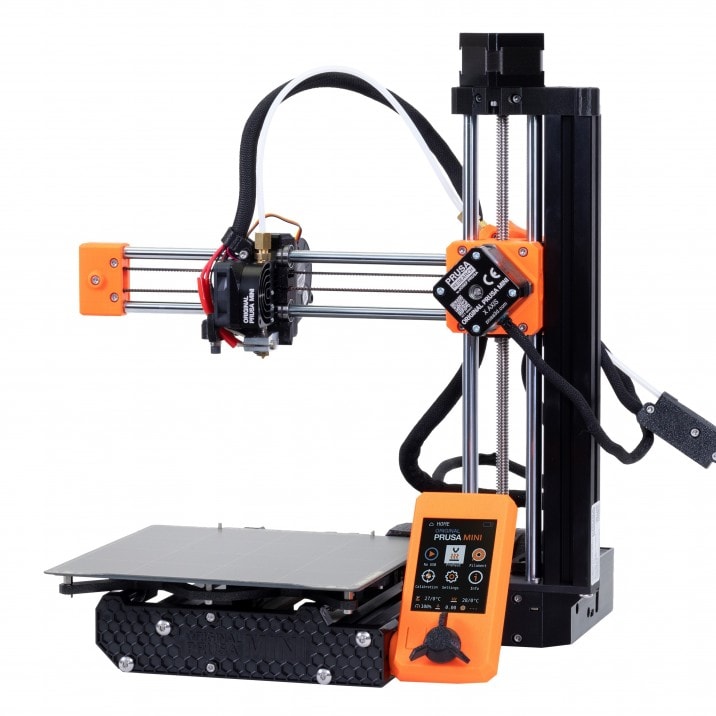
The Prusa MINI+ is the smallest FDM 3D printer in the Prusa lineup and stands out with its cantilever style design. It is designed for small workspaces and first-time 3D printer users who need a high-quality Prusa 3D printer on a budget.
The MINI+ comes with a modest build volume of 180 × 180 ×180 mm, which will suffice most basic 3D printing needs. It also includes a magnetic spring steel print bed that helps you remove your 3D prints easily.
Its automatic bed leveling probe ensures that you get an ideal first layer that sticks to the print bed every time. This removes the time-consuming process of manual bed leveling and makes it easier for beginners to get started with 3D printing.
The 32-bit 3D printer controller board on the MINI+ is equipped with Trinamic 2209 drivers that enable silent 3D printing. This is a welcome addition that cannot even be found on the larger i3 MK3S+.
The Prusa MINI+ is a great 3D printer for print farms, hobbyists, and beginners who need a reliable workhorse from the Prusa team. The price of $400 is modest, and for that, the MINI+ gives you a reliable 3D printer with a decent range of features and capabilities.
Standout Features
- SuperPINDA bed leveling probe
- Ethernet connectivity
- 32-bit motherboard
Technical Details |
|
|---|---|
| Print volume | 180 x 180 x 180 mm |
| Printing technology | FDM |
| Maximum nozzle temperature | 280 °C |
| Maximum bed temperature | 100 °C |
| Material support | PLA, PETG, ASA, ABS, PC (Polycarbonate), CPE, PVA/BVOH, PVB, HIPS, PP |
| Connectivity | Ethernet, USB |
What We Like
- Easy to use full-color control screen
- One-click 3D printing
- Automatic bed leveling
- Easy print removal
Could Be Better
- Costly
- Limited build volume
What to Look for When Buying a 3D Printer Under $500
Printing Technology
A filament printer utilizes a thermoplastic material to manufacture objects. PLA, ABS, PETG, TPU, and ASA filament are some common 3D printing materials that you can use with FDM printers. The advantages of FDM 3D printing are its low cost, significant build volume, and easy learning curve. Yet, the resolution of FDM parts is inferior compared to parts produced by resin printing.
In contrast, resin 3D printers produce very high resolution 3D prints. A resin printer utilizes photocuring resin and a UV light source to manufacture intricate prints. This technology results in 3D printed parts that have smooth surfaces, accurate dimensions, and high precision.
However, resin 3D printers are more expensive than filament printers, have a steeper learning curve, and are tedious to operate indoors.
A filament printer is most helpful if you want to 3D print large, strong, or functional components. They are also cheaper and easier to operate.
When looking at the best 3D printers under $500, filament printers give better value for your money. In contrast, resin 3D printing will be beneficial if you need to create high-detail models, like when 3D printing miniatures and figurines.

Filament Compatibility
A 3D printer with wide filament compatibility lets you print a broad range of materials and utilize 3D printing in various applications. The material compatibility of any FDM printer is determined by its design, maximum printing temperature, extrusion system, and the availability of a heated bed.
A 3D printer that supports a maximum temperature of 240-250°C and comes with a heated bed can print PLA, PETG, and low-temperature ABS filaments. But, if you want to print with advanced materials such as Nylon, Polycarbonate, and Polypropylene, you will need a high-temperature nozzle that can go above the 260 °C mark.
In this list of the best 3D printers under $500, the Ender 3 S1 Pro and the Voron 0.1 support high-temperature 3D printing. Being an enclosed printer, the Voron 0.1 will minimize the warping effects at high temperatures and deliver slightly better results. But, you can also enclose the Ender 3 S1 Pro with an aftermarket 3D printer enclosure and take advantage of its more considerable print volume.
Bed Leveling
Bed leveling is a crucial element in any 3D printing process, and it can influence the success or failure of your 3D prints to a large extent. Most budget 3D printers skip the automatic bed leveling feature to keep the costs low. 3D printers under $500, on the other hand, have enough room in their budget to incorporate a bed leveling sensor.
A leveled bed ensures that your first layer of the print sticks well to the print bed and results in a successful 3D print. Manual bed leveling is a tedious process and still doesn’t guarantee a perfectly leveled print bed before each print.
An automatic leveling probe, like a BLTouch or CRTouch, will help a 3D printer automatically calibrate for any irregularities in the bed’s surface and adjust the first layers of the 3D print. Aside from the Voron 0.1 and the Flashforge Dreamer, all the 3D printers on this list have an automatic bed leveling feature.
Build Volume
The build volume of a 3D printer dictates the types of models you can 3D print on it. The best 3D printers under $500 come with a variety of build volumes, from small to large.
If you need a 3D printer for small models or miniatures, you can get away with a 3D printer that has a small build volume. On the other hand, a larger build volume is a must if you want to 3D print large objects, like terrains, life-size figurines, cosplay items, or other large models.
Of course, you can always split 3D models and print them in separate parts. However, this can be a time-consuming endeavor with sub-optimal end results. A 3D model that is printed as a whole will be superior to one made from separate parts that were assembled.
FDM 3D printers have larger build volumes compared to similarly priced resin 3D printers. For example, the Elegoo Saturn S is priced at almost $450, yet has a smaller print area than the equally priced Creality Ender 3 S1.
If you want to buy a 3D printer under $500 and build volume is your priority, the 400 x 400 x 450 mm print area of the Anycubic Chiron will be your best option. But, if you do not need a large-format 3D printer, the Creality Ender 3 S1 and the Prusa MINI+ still offer you a decent print volume and come with loads more advanced features.
Enclosure
An enclosure helps to maintain a constant temperature in the print chamber, reducing the warping of your 3D prints. It also keeps the 3D printer fumes inside the build area and limits your exposure to them.
The enclosure acts as a safety buffer too, as it protects users from the hot elements of the 3D printer and helps prevent accidental burns. On an open-frame form-factor 3D printer, you do not have this protection.
The major drawbacks of enclosed 3D printers are the increased price and small build volume. The enclosure takes up a lot of desktop space, and you get a small print area compared to a similarly priced open, metal frame 3D printer.
The Voron 0.1 and the Flashforge Adventurer 3 Pro come with an enclosure. The Flashforge printers are beginner-friendly, come fully assembled, and the enclosed chamber makes them ideal for use in schools, indoors, and around children.
Connectivity
The connectivity of a 3D printer is often an overlooked factor by manufacturers. Typically, you’ll get a USB port and a micro SD card on the 3D printer. But, these options often limit the flexibility of the 3D printer and do not facilitate easy wireless 3D printing.
The Prusa MINI+ is the leading 3D printer on this list regarding connectivity options. It has a USB port as well as an Ethernet connection. The ethernet port allows you to connect several 3D printers on a single network, which you can easily control from a single computer.
The Flashforge Adventurer 3 Pro also has good connectivity, as it comes with a Wi-Fi connection. Using the FlashCloud software, you can remote 3D print and use its built-in camera to monitor the progress of your print.
What to Expect From a 3D Printer Under $500
It is important to temper your expectations when buying in this price range, even if it is the best 3D printer under $500 for you. You’ll never get all the bells and whistles and top-of-the-line performance of industrial or even sub-$1000 or sub-$2000 3D printers.
But, that doesn’t mean that 3D printers under $500 are not worth your time and money. We have listed some great options that can give you a great 3D printing experience. All options on this list provide excellent value for the money. Depending on your specific requirements, one or more of these 3D printers are going to be great for your needs, without you having to spend excessive amounts of money.
Which Type of 3D Printing is Cheapest?
Fused deposition modeling is the cheapest type of 3D printing. It works by extruding molten plastic through a nozzle, which is deposited layer by layer to build up the desired object. Both the 3D printer and the filament are significantly cheaper than resin printers and their materials.
If you are looking for the cheapest possible 3D printing technology, fused deposition modeling is the way to go. The most important thing you need to keep in mind when choosing this technology is that you are sacrificing on print detail/resolution. However, you can still achieve excellent results if you calibrate your printer correctly and use the right type of filament.
How Much is a Beginner 3D Printer?
For a decent entry-level beginner 3D printer, you can expect to pay around $200 to $500. Anything less than that and you’re not buying anything worth your time.
3D printers are becoming more and more popular, so the prices are coming down. But if you want something that delivers good results and is reliable, you’ll need to spend at least a few hundred dollars.
Are Sub-$500 3D Printers Worth Buying?
The best 3D printers under $500 are in a sweet spot between being affordable for most people and offering features that serious hobbyists and makers need. At this price point, you’ll find some excellent machines that can do a lot of different things.
If you are just starting out with 3D printing and have no specific needs, there isn’t much reason to spend more than $500 on a 3D printer. Later, once you have a better idea of what you want to do with 3D printing, you can always upgrade to a more expensive machine.
Conclusion
There are a variety of 3D printers available in the $500 price bracket, and these printers come with an advanced set of features designed to enhance the overall user experience. To make it easy for you to select your ideal 3D printers, we’ve shortlisted the top three best 3D printers under $500.
The Creality Ender 3 S1 ranks on the top and is in our opinion the best 3D printer under $500. It comes with the latest features, good build quality, and an improved design to deliver the best quality 3D printing. It is an excellent choice for beginners, hobbyists, and prosumers who need a sturdy and reliable 3D printer.
The Prusa Mini+ and the Elegoo Saturn S are the next best 3D printers that you can get below the $500 category. The Mini+ has excellent reliability and delivers high-quality 3D prints. On the other hand, the Elegoo Saturn S is a value-for-money resin printer with its large build volume and built-in air purifier.
Which ones from the list are your favorite 3D printers? Do you have any experience using any one of them? Let us know and if you have anything else to add, feel free to comment below.
